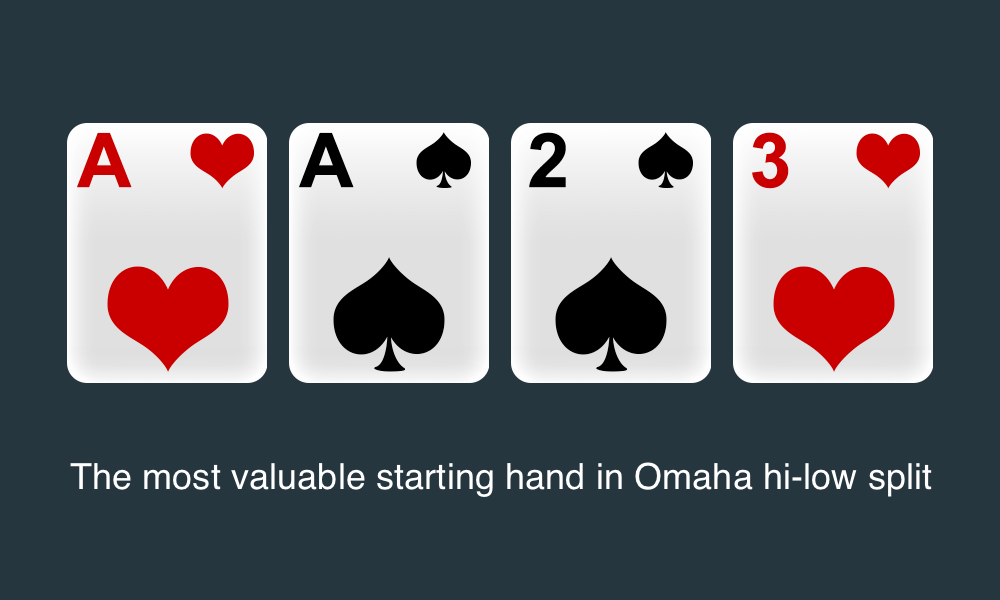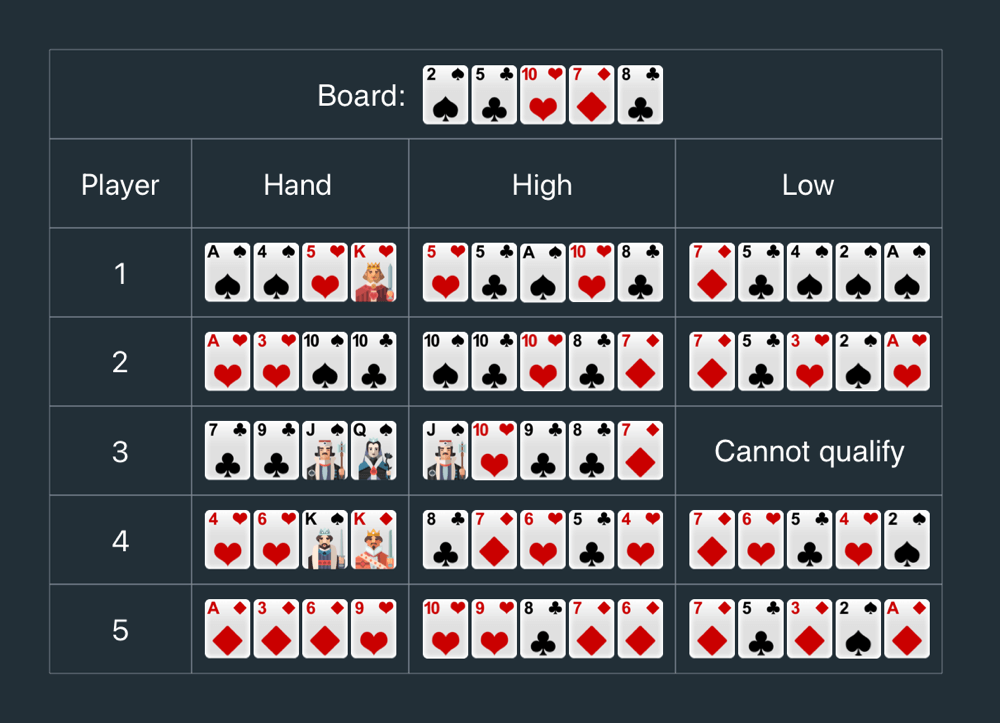Introduction
Omaha Hi-Lo split, also known as Omaha 8 or better, or Omaha 8, is a variant of Omaha Hold’em. The pot is split between the players with the highest and lowest hands. The best high hand wins half of the pot, and the best low hand wins the other half of the pot.
Omaha Hi-Lo involves four hole cards for each player. The object of Omaha 8 is to make the best five-card high hand, and/or best five-card low hand, using exactly two hole cards and three community cards. Different combinations of cards can be used by a player to make separate high and low hands.
This is commonly played as a fixed limit game. The deal is the same as in Omaha High, but with fixed limits the size of the bet doubles after the turn card is dealt, so that the third and fourth betting rounds are played with big bets.
How to play Omaha Hi-Lo
Dealing and Betting
Omaha Hi-Lo is usually played with no ante, but with blinds. When there are more than two players, the player to dealer's left places a small blind, and the next player to the left a big blind. The big blind is equal to the minimum bet and the small blind is typically half that amount. When there are only two players (a "heads-up" game), the dealer places the small blind and the non-dealer the big blind.
The cards are shuffled and cut, the dealer "burns" one card and then deals the cards one at a time face down until each player has four cards. These are known as the player's hole cards or pocket cards. Players may look at their four hole cards and must not show them to any other player.
The first betting round is begun by the player to the left of the big blind. The blinds count as bets, so the small blind need only pay the difference between the blinds to call. The big blind player acts last and is allowed to raise, even if the other active players have all called.
After the first betting round the dealer burns one card and deals three cards face up to the table. These three cards are known as the flop. There is then a second betting round begun by the first active player to the left of the dealer seat.
When the second betting round is complete, the dealer burns a card and then deals one card face up to the table. This card is known as the turn or fourth street. There is then a third betting round, again begun by the first active player to the left of the dealer seat.
After the third betting round the dealer burns another card and deals one more card face up - the river or fifth street. There is fourth and final round of betting before the showdown, again begun by the first active player to the left of the dealer seat.
The Showdown
Active players show all four of their cards in clockwise order, beginning with the who was the last to bet or raise in the final betting round. If everyone checked in the final betting round, the first active player to the left of the dealer seat is the first to show.
To qualify for low, a player must be able to play an 8-7-6-5-4 or lower (this is why it is called "eight or better"). Each player can play any two of their four hole cards to make their high hand, and any two of their four hole cards to make their low hand. If there is no qualifying low hand, the high hand wins (scoops) the whole pot.
Example
In the deal above, player 3 wins the high-hand half of the pot with their J-high straight, and player 2 and player 5 split the low half (getting a quarter of the pot each) with 7-5-3-2-A.
Specific Things to Notice
- In order for anyone to qualify low, there must be at least three cards of differing ranks 8 or below on the board. For example, a board of K-8-J-7-5 makes low possible (the best low hand would be A-2, followed by A-3, 2-3, etc.) A board of K-8-J-8-5, however, cannot make any qualifying low (the best low hand possible would be J-8-5-2-A, which does not qualify). Statistically, around 60% of the time a low hand is possible.
- Low hands often tie, and high straights occasionally tie as well, as do, even more rarely, full houses. In theory, it is possible to win as little as a 14th of a pot (though this is extraordinarily rare). Winning a quarter of the pot is quite common, and is called "getting quartered." One dangerous aspect of playing for the low pot is the concept of "counterfeiting". To illustrate, if a player has, for example, 2-3 and two other cards in their hand and the flop is A-6-7, that player has flopped the "nut low". However, if either a 2 or a 3 hit the board on the turn or the river, the hand is "counterfeited" and the nut low hand is lost (the player still has a much weaker low hand however, with 3-4, 3-5 and 4-5 making better lows). This is why there is significant extra value in possessing the "protected" nut low. To illustrate this, if the player has 2-3-4 in their hand their low is protected, i.e. if a 2 or 3 hits the board he still has the lowest possible hand. To lose the nut low in this case either a 2 and a 3, a 2 and a 4, or a 3 and a 4 would have to hit the board on the turn and the river (giving the nut low to a player holding 4-5, 3-5 and 2-5, respectively), an unlikely possibility. For similar reasons it is significantly better to possess the protected nut low draw over the low draw. For example, this could be having A-2-3 with a flop of 7-8-9; any low card below 7 on the turn or river gives the player the best low.
- When four or five low cards appear on the board, it can become very difficult to read the low hands properly. For example, with a board of 2♦ 6♥ A♣ 5♣ 8♠, the hand 2♥ 4♠ 5♠ K♦ is playing a 6-5-4-2-A (either their 2-4 with the board's A-5-6, or their 4-5 with the board's A-2-6--either way makes the same hand). In this situation he is often said to be playing their "live" 4, that is, their 4, plus some other low card that matches the board but still makes a low because the one on the board isn't needed. A player with 3♠ 5♠ 10♥ J♦ is playing a "live" 3, for a low of 6-5-3-2-A, which makes a better low. However, a player with 3♣ 7♦ Q♦ Q♠ can only play 7-5-3-2-A low; even though he has a "live" 3, he must play two low cards from their hand, and so he must play their 7-3, and cannot make a 6-high low hand.
- Starting hands with three or four cards of one rank are very bad. In fact, the worst possible hand in the game is 2♠ 2♣ 2♥ 2♦. Since the only possible combination of two cards from this hand is 2-2, it is impossible to make low. As no deuce remains to appear on the board, it will be impossible to make three deuces or deuces full, and anyone with any matching card to the board will make a higher pair. Likewise, starting with four cards of one suit makes it less likely that you will be able to make a flush. Starting with four different suits yields no chance for a flush, and starting with four disconnected cards reduces straight possibilities. Computer analysis of the best starting hands has proven that the best starting hand for Omaha is A-A-K-K (double suited). One favorite starting hand for Omaha is A-A-J-10 (double suited), because of its wider range for making the nut straight (J-7, Q-8, K-9, and A-10). For the Hi-Lo variation, the most valuable starting holding is A-A-2-3 (double suited).
- Hands to avoid tend to contain mainly middle-ranked cards, which are of little use for any low splits and which tend to generate lower pairs and sets, weaker flushes and lower straights and can be very expensive. Four of a kind is the worst possible starting hand in Omaha, in contrast to most other poker games, where it is exceptionally strong.
- Straights and flushes are ignored when judging low hands. Low hand ranks from best to worst: 5-4-3-2-A (the wheel), 6-4-3-2-A, 6-5-3-2-A, 6-5-4-2-A, ..., 8-7-6-5-4. Low hands can thus be read as numbers between 54,321 and 87,654 (with the exception of any number that has a pair, i.e. 54,322). The lowest number that any player can make, while ordered from high card to low, is the best possible low hand in play. For example: 2♠ 3♣ 5♥ 6♥ 7♥ wins over A♠ 2♣ 3♥ 4♣ 8♠








